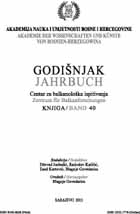Odlike obilježja nad mezarom Ferhad-bega, sina Iskenderova, vakifa kasabe Tešanj
Characteristics of the mark of the Ferhad-bey’s grave, son of Iskender, vakif of Tešanj town
Author(s): Mirza Hasan ĆemanSubject(s): History
Published by: Akademija Nauka i Umjetnosti Bosne i Hercegovine
Summary/Abstract: In this article author discusses characteristics of the mark of the Ferhad-bey’s grave, son of Iskender, vakif (founder) of Tešanj kasaba (town) in the Northern Bosnia. This grave mark was erected in 1568 or immediately after this year, and it is composed of subconstruction, sarcophagus and nišans (grave markers) placed on the sarcophagus. The usage of different petrographic materials in the construction of the grave marker is noticeable. Petrographic material of the hreša type probably from the vicinity of Sarajevo was used for the sub-construction and sarcophagus, and material of the “crystal stone of Skopje type” was used for the nišans .Author analyses the appearance of two petrographic materials of the grave marker in the context of aesthetic and artistic tendencies of sculptors and constructors of that time, and in the context of historical circumstances which as a consequence lead to the destruction of the nišans and devastation of the sarcophagus in the time of the attack of Austrian troops under the command of prince Eugene of Savoy in 1697. Two possibilities for the usage of different petrographic materials on the grave marker could be supposed: first is contemporary usage of two petrographic materials in the time of the original erection of the monument, and second is the reconstruction of nišans made of “crystal stone of Skopje” after the devastation in 1697. Author identifies the “crystal stone of Skopje” which is known as the “crystal marble from Aranđelovo near Skopje”, as the petrographic material which belongs to the family of metamorphic rocks, receptively to the sub-group of dolomite marbles. With its characteristics this material could be related to one very famous petrographic material exploited in the area north-northeast of Prilep, and it is well known by its commercial name sivec and sivec kalciten. Author, also, identifies the existence of the stonecarvers and stone-sculptors workshops in Macedonia, most probably in the Skopje (Üsküb – turkish name for Skopje), which placed their products in the area of Bosnian sandžak, respectively ejalet, from the middle of 16 century to the beginning of 18 century.
Journal: Godišnjak Centra za balkanološka ispitivanja
- Issue Year: 2011
- Issue No: 40
- Page Range: 255-275
- Page Count: 21
- Language: Bosnian

